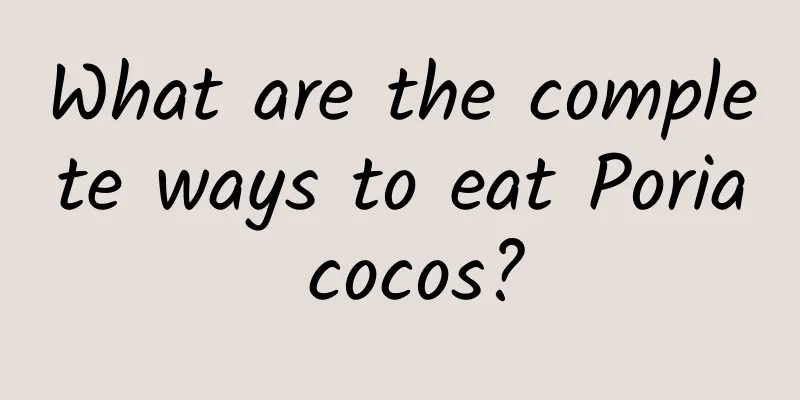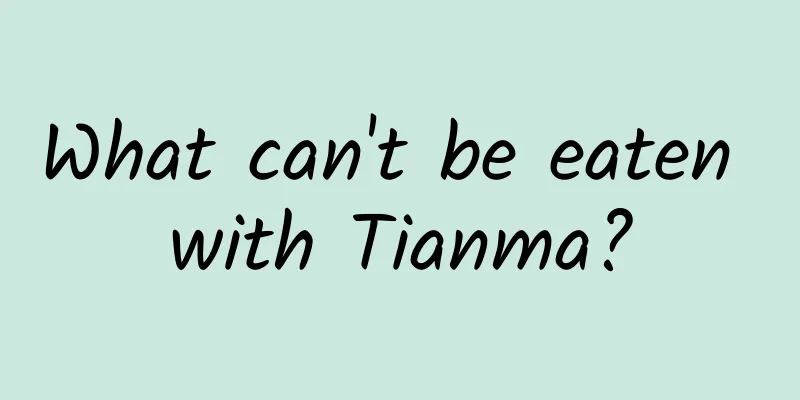What are the complete ways to eat Poria cocos?

|
Poria cocos is a very common Chinese medicinal material in life. Poria cocos is very effective in nourishing the body. There are many ways to eat Poria cocos. It can be eaten directly or cooked. Although Poria cocos is suitable for all ages, it is best for pregnant women to eat it. There are many ways to eat Poria cocos. Poria cocos can be used to soak in water or make soup, and can also be used to cook porridge. It not only tastes good, but also is very nutritious. How to eat Poria cocos Poria tofu Raw materials: 20g Poria powder, 500g tofu, carrots and mushrooms (for 3 people). Cooking method: Mix Poria powder and tofu evenly, season with salt and cooking wine, then put carrots and soaked mushrooms into the pot and stir-fry until half-cooked, then put tofu into the pot, add appropriate amount of water, turn to low heat and simmer slowly. It is best to season and serve. It can strengthen the spleen and eliminate dampness, help digestion and lose weight. Since the main ingredient of this medicinal food is tofu, people with renal insufficiency and gout should not eat too much. Lotus Leaf and Poria Cocos Porridge Ingredients: 1 lotus leaf (fresh or dried), 50 grams of Poria cocos, 100 grams of polished rice or millet, and appropriate amount of white sugar. Method: 1. Boil lotus leaves and remove the residue. Add Poria cocos and washed polished rice or millet into the soup. 2. Cook into porridge together, add sugar for seasoning before serving. Efficacy: This porridge can clear away heat and relieve summer heat, calm the mind and soothe the nerves, stop diarrhea and dysentery, and has an auxiliary therapeutic effect on patients with cardiovascular diseases and neurasthenia. The efficacy and function of Poria cocos 1. Calming the mind and soothing the spirit "Bencao Jingshu" records: Poria cocos can "open the chest, regulate the internal organs,... nourish the heart and benefit the spleen..." Chinese medicine often uses Poria cocos to regulate symptoms such as restlessness, palpitations, depression, insomnia, and nightmares. 2. Strengthen the spleen and replenish qi "Bencao Yanyi" records that Poria "is indispensable for benefiting the heart and spleen." "The Heart of Using Medicines" records that Poria "benefits the spleen, expels water, produces body fluids and guides qi." Traditional Chinese medicine believes that it has the effect of treating both the symptoms and the root cause of diarrhea and leucorrhea caused by spleen deficiency and abnormal metabolism. Therefore, Poria cocos is often used as an auxiliary medicine for strengthening the spleen and replenishing qi deficiency. 3. Regulate phlegm and dampness "Shibuzhai Medical Art" records: "Poria cocos is the main medicine for treating phlegm. The root of phlegm is water, and Poria cocos can promote the flow of water. The movement of phlegm is dampness, and Poria cocos can also promote the flow of dampness." Poria cocos has a significant therapeutic effect on symptoms such as spleen deficiency, inability to transport and transform water and dampness, and accumulation and transformation of phlegm and fluid. 4. Nourishing the middle and strengthening the stomach "Bencao Zheng" records: Poria cocos can "tonify the middle and strengthen the stomach; eliminate epilepsy, thicken the intestines..." Modern medical research believes that Poria cocos has a direct relaxant effect on the isolated intestinal tract of rabbits, has a preventive effect on ulcers formed by pyloric ligation in rats, and can reduce gastric acid. Therefore, Poria cocos is a good medicine for treating gastrointestinal diseases. 5. Diuretic "Compendium of Materia Medica" records: "Poria cocos has a light and penetrating smell, its nature is upward, it produces body fluids, opens the pores, nourishes the water source and descends, and promotes urination..." Therefore, Chinese medicine often uses Poria cocos to regulate symptoms such as urinary problems and edema. Poria cocos has a mild medicinal property and promotes diuresis without harming the body. 6. Anti-tumor Poria cocos is rich in Poria polysaccharides, vitamins, selenium and other trace elements, which can enhance the immune function of human cells and body fluids and improve bone marrow hematopoietic function. Modern medical experiments have confirmed that Poria polysaccharide has a significant inhibitory effect on mouse sarcoma. It can also enhance the appetite of cancer patients, control symptoms, and reduce the side effects of radiotherapy and chemotherapy. Precautions for taking Smilax glabra May cause itching in people with allergies Traditional Chinese medicine indicates that there are some people in real life who are allergic to wild yam. People with this special physique may experience itchy skin and papules on the skin if they take medicinal food containing wild yam without knowing it. Severe cases may even cause erythematous papules, which will cause serious discomfort to the allergic people. Therefore, it is best to consult before eating wild yam. Avoid drinking tea after eating Smilax glabra Tea is a very popular drink among the Chinese people. However, many Chinese medicine practitioners will remind you to temporarily stop drinking tea when taking traditional Chinese medicine, because some elements in tea leaves may react with some of the medicines in the prescription, greatly reducing the effectiveness of the medicine. And wild yam is also a traditional Chinese medicine that easily reacts with tea, which may greatly reduce the medicinal efficacy of wild yam. Therefore, it is better not to drink tea after eating wild yam. |
>>: What are the ways to eat fresh Dendrobium?
Recommend
Precautions for taking Chinese medicine raw or cold
Chinese medicine emphasizes conditioning with Chi...
Should I take Chinese medicine for regulating the spleen and stomach before or after meals?
In daily life, many people also have poor gastroi...
The efficacy and function of the fan-leaf herringbone fruit
Fan-leaf herringbone fruit has attracted our atte...
Lingnan Prehistoric History: The World's Greatest Dinosaurs
What is Lingnan? Since the Yanshan Movement forme...
He sleeps and I'm crazy! Why don't people who snore wake themselves up? It turns out it's all related to "them"...
This article was reviewed by Tao Ning, PhD, Assoc...
The efficacy and role of tortoise shell [picture]
Turtle shell [picture] is a medicinal material, w...
What are the effects and functions of borneol?
Borneol, also known as borneol, is a commonly use...
The efficacy and function of tea tree flowers
Tea tree flower is a kind of traditional Chinese ...
What are the medicinal values of Polygonum multiflorum
Polygonum multiflorum is a traditional Chinese me...
What are the ways to drink Jiaogulan?
Long-term bad eating habits and lack of exercise ...
The efficacy and function of antler ganoderma
Deer are a symbol of longevity. Deer antler is a ...
This "short-legged" creature weighs only 7 kilograms, but can hunt a 300-kilogram South American tapir?
There is a saying in Buddhism that goes "Eve...
The efficacy and function of Panax notoginseng
Wild Panax notoginseng is one of the common tradi...
What is the secret recipe of beef offal and Chinese medicinal spices?
If you want to cook beef offal deliciously, you n...









